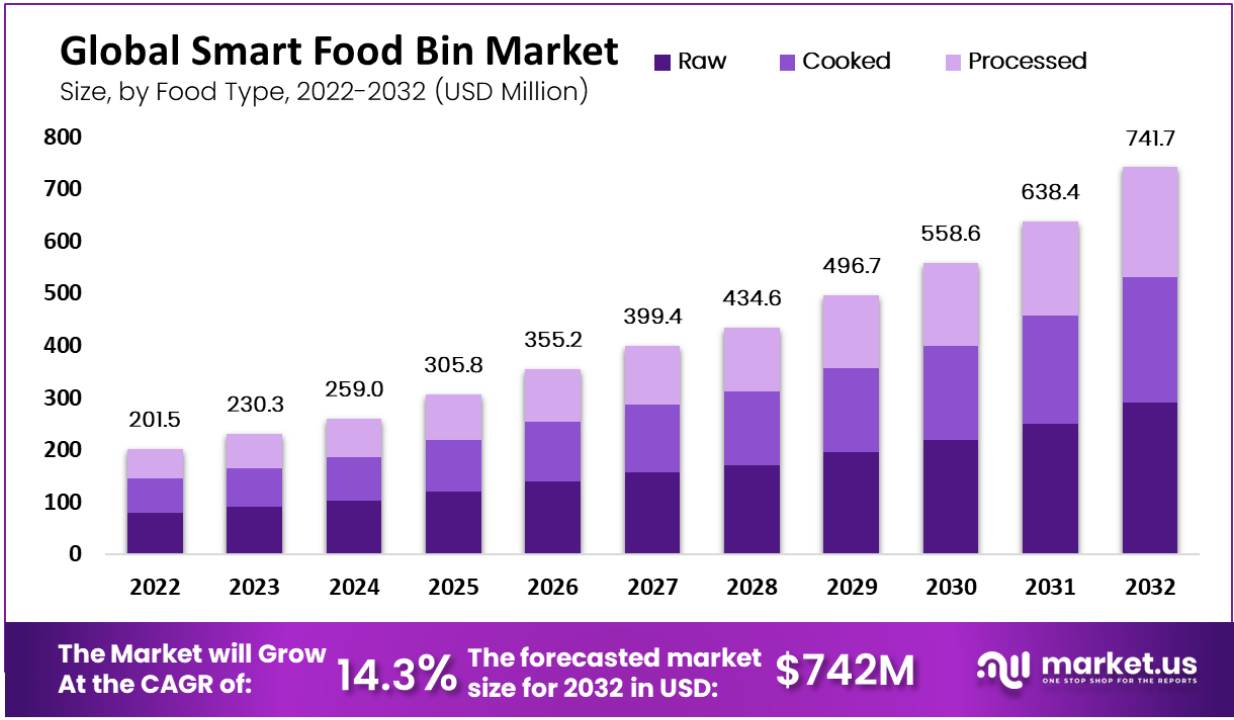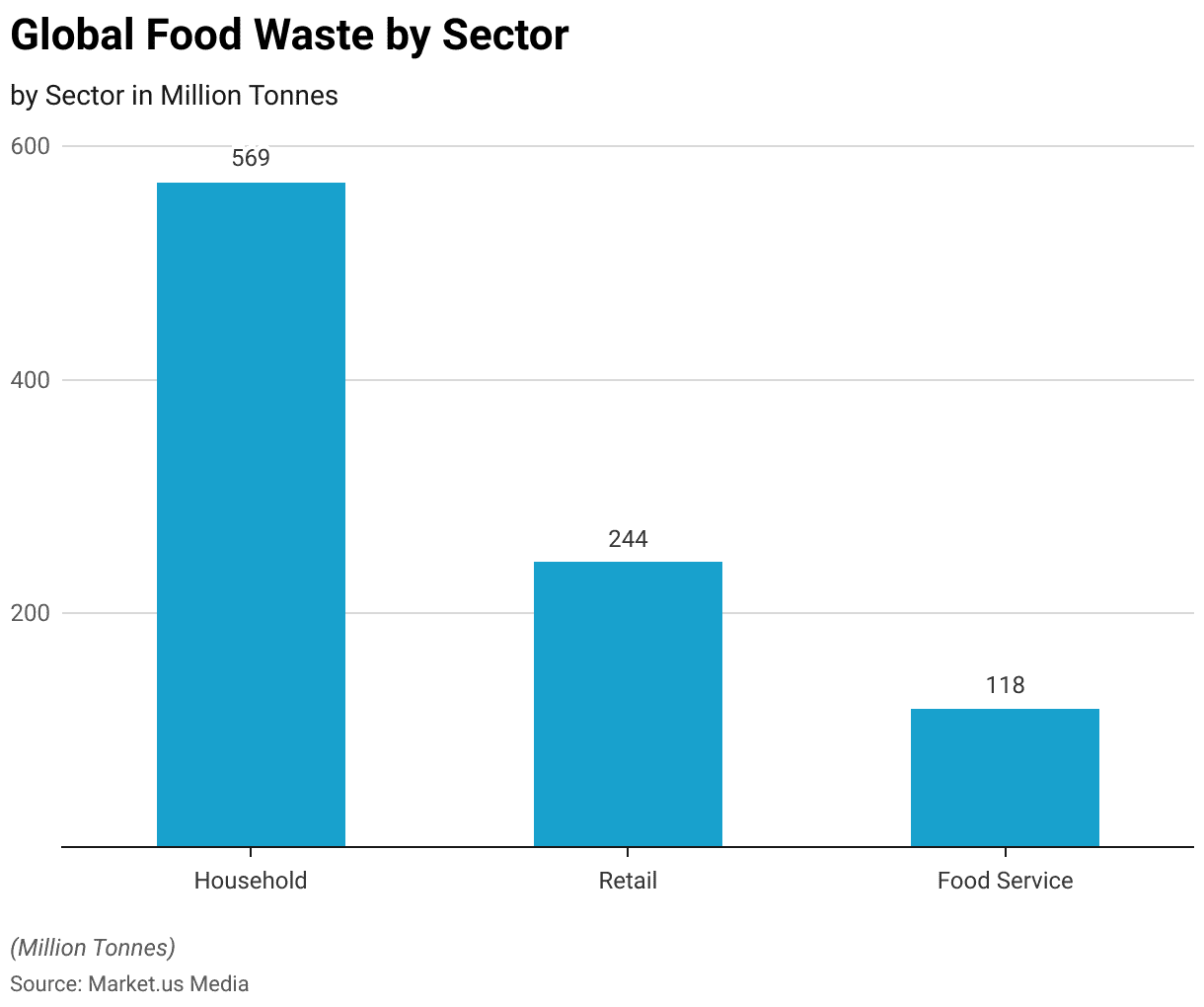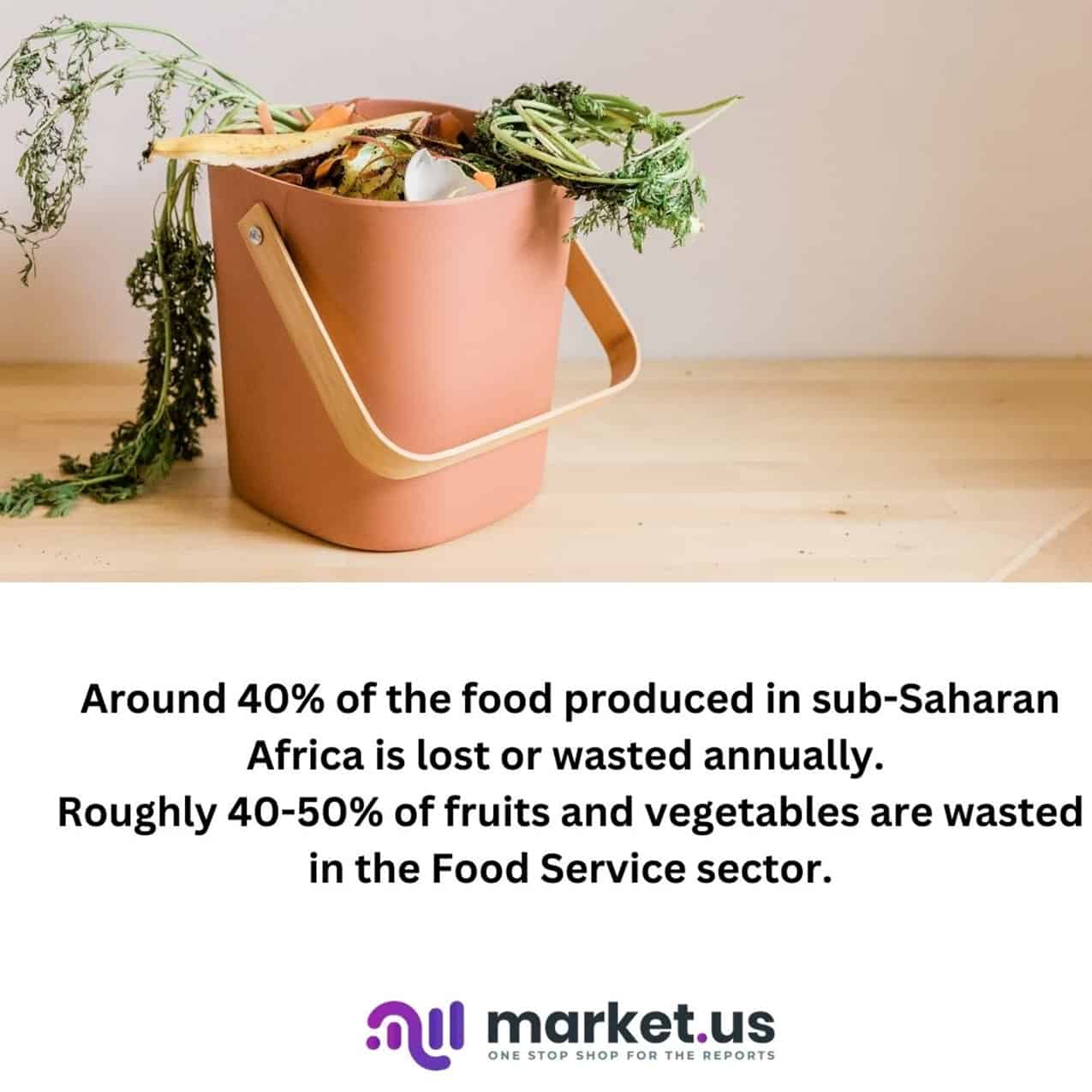Food Waste Statistics: Food waste is a significant global issue that affects both developed and developing countries. It refers to the loss or disposal of edible food along the entire food supply chain, from production and processing to distribution, retail, and consumption.
Food waste occurs when food that is safe and suitable for human consumption is discarded, whether due to spoilage, overproduction, or consumer behavior.

Table of Contents
- Key Facts About Food Waste
- Editor’s Choice
- Food Waste Statistics – Overview
- Food Waste Statistics – Household Sector
- Food Waste Statistics – Retail Sector
- Food Waste Statistics – Food Service Sector
- Food Waste Statistics – Environmental Impacts
- Economic Implications of Food Waste
- Food Waste in Developing Countries
- Strategies and Solutions to Reduce Food Waste Statistics
- Recent Developments
- Wrap Up
- FAQs
Key Facts About Food Waste
- Approximately 14% of food produced worldwide is lost between harvest and retail.
- An estimated 17% of total global food production is wasted, with 11% occurring in households, 5% in the food service industry, and 2% in retail.
- Food loss and waste account for 38% of total energy usage in the global food system.
(Source: United Nations)
Editor’s Choice
- In 2022, the global Smart Food Bin Market was valued at US$ 201.5 million and will reach US$ 741.7 million by 2032. Between 2023 and 2032, this market is estimated to register the highest CAGR of 14.3%.
- Approximately 1.3 billion tonnes of food are wasted globally each year.
- Approximately 690 million people suffer from chronic hunger worldwide. While an estimated 1.3 billion tons of food are wasted annually.
- Food waste accounts for about one-third of all food produced for human consumption worldwide.
- The economic cost of global food waste is estimated to be around $1 trillion annually.
- In developing countries, a significant portion of food waste occurs during production and post-harvest handling, while in developed countries, most waste happens at the consumer level.
- Food waste is a major contributor to greenhouse gas emissions, with approximately 8% of global emissions attributed to wasted food.
- Industrialized countries waste almost as much food (222 million tonnes) as the total net food production of sub-Saharan Africa (230 million tonnes).
- Food waste exacerbates global water scarcity, with about 24% of all water used for agriculture ultimately wasted due to discarded food.
- The United States wastes approximately 30-40% of its food supply, amounting to approximately 133 billion pounds and $161 billion worth of food annually.
(Source: FAO)

Food Waste Statistics – Overview
- Approximately 1.3 billion metric tons of food are wasted globally each year.
- This amount is equivalent to about one-third of all food produced for human consumption.
- High-income regions, such as North America and Europe, tend to have higher levels of food waste per capita compared to low-income regions.
- Industrialized countries waste about 222 million tons of food annually, which is nearly as much as the entire net food production of sub-Saharan Africa (230 million tons).
- Food waste contributes to approximately 8% of global greenhouse gas emissions. If food waste were a country, it would be the third-largest emitter after the United States and China.
- Wasted food occupies around 1.4 billion hectares of land, which accounts for about 30% of the world’s agricultural land area.
- The water footprint of food waste is approximately 250 km³ per year, equivalent to the annual flow of Russia’s Volga River, the largest river in Europe.
- The household sector accounts for approximately 569 million tonnes of food waste globally.
- The retail sector contributes around 244 million tonnes of food waste to the global total.
- Within the food service industry, approximately 118 million tonnes of food are wasted worldwide.
(Source: FAO, Intergovernmental Panel on Climate Change, IPCC, Statista)

Food Waste Statistics – Household Sector
- The household sector accounts for about 53% of total global food waste.
- In high-income countries, households waste approximately 95-115 kg of food per capita per year.
- Low and middle-income countries experience per capita household food waste ranging from 6-11 kg annually.
- Roughly 40% of food wasted by households is fruits and vegetables.
- Bread and cereals contribute to around 20% of household food waste.
- Dairy products, such as milk and cheese, account for approximately 15% of household food waste.
- Meat and fish waste make up roughly 8-10% of household food waste.
- Prepared and leftover meals contribute to about 8% of food wasted in households.
- In high-income countries, consumers discard around 10-15% of food purchases.
- Lack of awareness and improper meal planning are major contributors to household food waste.
(Source: FAO)
Food Waste Statistics – Retail Sector
- Approximately 2% of total global food production is wasted in the retail sector.
- Retail food waste accounts for an estimated 244 million units of food globally.
- In the United States, the retail sector is responsible for discarding around 43 billion pounds (19.5 million metric tons) of food annually.
- Supermarkets and grocery stores in the United Kingdom generate approximately 200,000 tons of food waste each year.
- In Australia, the retail sector wastes an estimated 7.3 million tons of food annually.
- Roughly 40% of food waste in the European Union occurs in the retail and wholesale sectors.
- A survey conducted in Canada found that retailers contribute to around 10% of the country’s total food waste.
- In South Africa, retailers discard approximately 2.8 million tons of food each year.
- Retail food waste in India is estimated to be around 5-16 million tons annually.
- The retail sector in China generates about 35 million tons of food waste per year.
(Source: NRDC, Wrap UK – Waste and Resources Action Programme, Department of Agriculture, RTS, Second Harvest Canada, National Agricultural Marketing Council – South Africa, Indian Chamber of Food and Agriculture, World Resources Institute)
Take advantage of our unbeatable offer - buy now!

Food Waste Statistics – Food Service Sector
- Food Service sector contributes to approximately 10% of global food waste.
- Around 5% of total global food production is wasted in the Food Service sector.
- Food waste in restaurants and catering establishments accounts for an estimated 14% of their total expenses.
- In the United States, the Food Service sector generates over 11 million tons of food waste annually.
- Restaurants and food service providers waste an average of 4-10% of the food they purchase.
- Buffet-style operations have a higher food waste generation rate compared to other types of food service establishments.
- Food waste in the Food Service sector is primarily driven by overproduction, spoilage, and plate waste.
- Roughly 40-50% of fruits and vegetables are wasted in the Food Service sector.
- In Europe, the Food Service sector accounts for 14% of total food waste generated across the supply chain.
- Implementing food waste reduction strategies in the Food Service sector could save businesses up to $1.6 billion annually in the United States.
(Source: World Resources Institute, Environmental Protection Agency, European Commission)

Food Waste Statistics – Environmental Impacts
- Food production contributes to 26% of global greenhouse gas emissions.
- Agriculture occupies 50% of the world’s habitable land, excluding areas covered by ice and deserts.
- 70% of global freshwater withdrawals are used for agricultural purposes.
- Agriculture is responsible for 78% of global ocean and freshwater eutrophication, which refers to water pollution caused by nutrient-rich runoff.
- Livestock accounts for 94% of the total biomass of non-human mammals. This means livestock outweighs wild mammals by a factor of 15-to-1.
- Poultry livestock comprises 71% of bird biomass, surpassing the biomass of wild birds by a factor of more than 3-to-1.
- The carbon footprint of food waste is estimated to be 3.3 billion metric tons of CO2 equivalent annually.
- Wasted food accounts for about 25% of global freshwater consumption.
- Approximately 1.4 billion hectares of land, roughly 28% of the world’s agricultural area, are used to produce food that is ultimately wasted.
(Source: ourworldindata, FAO)
Economic Implications of Food Waste
- The global economic cost of food waste is estimated to be around $1 trillion annually.
- In high-income countries, the annual economic cost of food waste is approximately $680 billion, while in low- and middle-income countries, it amounts to about $310 billion.
- Food waste throughout the supply chain leads to significant financial losses for farmers, producers, and retailers, with losses ranging from 15% to 30% of total production value.
- The hospitality sector incurs substantial economic losses due to food waste, with restaurants and food service establishments experiencing profit losses of up to 4% due to wasted food.
- Efficient management of food waste can generate economic benefits. For every $1 invested in food waste reduction initiatives, there is an average return of $14 in cost savings.
(Source: World Bank, FAO, Food Waste Reduction Alliance, UNEP)
Food Waste in Developing Countries
Sub-Saharan Africa
- Around 40% of the food produced in sub-Saharan Africa is lost or wasted annually.
- In sub-Saharan Africa, post-harvest losses can range from 15% to 50% for cereals, roots, and tubers.
- Per capita, food waste in sub-Saharan Africa is estimated to be 6-11 kg per year.
(Source: World Bank, Food and Agriculture Organization – FAO)
South Asia
- South Asian countries waste an average of 8-10% of their food production annually.
- In India, approximately 40% of the food produced is wasted, valued at around $14 billion annually.
- In Bangladesh, post-harvest losses for perishable crops can be as high as 40%.
(Source: Indian Council of Agricultural Research, FAO)
Latin America
- Food losses and waste in Latin America and the Caribbean account for about 15% of total food production.
- In Brazil, food waste represents approximately 10% of total food production.
- In Mexico, around 37% of food available for human consumption is lost or wasted.
(Source: Inter-American Development Bank, Mexican Ministry of Agriculture and Rural Development)
Middle East and North Africa
- In the Middle East and North Africa region, food losses and waste range from 250 to 450 kg per capita annually.
- In Egypt, food waste is estimated at around 30% of total food production.
- In Saudi Arabia, the annual value of food waste is estimated to be $13.3 billion.
(Source: Saudi Arabia’s Ministry of Environment, Water, and Agriculture)
Strategies and Solutions to Reduce Food Waste Statistics
Food Recovery and Redistribution
- In the United States, food banks and other charitable organizations recover and redistribute approximately 3 billion meals each year.
- The European Union’s food donation initiatives help save around 47 million meals annually.
- The United Kingdom’s FareShare redistributed 28,500 tons of surplus food in 2020, providing 72.6 million meals to those in need.
(Source: Feeding America, European Commission, FareShare)
Improved Storage and Transportation
- Improved storage infrastructure and techniques can reduce post-harvest losses by up to 50% in some developing countries.
- In India, the use of metal silos for grain storage has reduced grain losses from around 20% to less than 2%.
- Cold chain systems in developing countries have the potential to reduce food waste by up to 20%.
(Source: World Bank, FAO)
Consumer Education and Awareness
- In the United Kingdom, the “Love Food Hate Waste” campaign helped reduce avoidable household food waste by 21% between 2007 and 2015.
- In South Korea, consumer education campaigns have contributed to a 27% decrease in household food waste between 2013 and 2018.
- A study in the United States found that educational interventions targeting consumers can reduce food waste by 10-25%.
(Source: Wrap UK, Environmental Science & Technology)
Policy and Regulatory Measures
- France introduced a law in 2016 that prohibits supermarkets from throwing away unsold food, leading to a 30% reduction in food waste within the first year.
- The United States Department of Agriculture (USDA) and Environmental Protection Agency (EPA) set a national goal to reduce food waste by 50% by 2030.
- The European Union’s Circular Economy Action Plan includes targets to halve food waste by 2030 and reduce food waste along the entire supply chain.
(Source: Ministry of Agriculture and Food, France, USDA and EPA, European Commission)
Recent Developments
Technology Innovations:
- Food waste tracking and management solutions have emerged, utilizing IoT sensors and data analytics to monitor food inventory, expiration dates, and consumption patterns in real time.
- Smart kitchen appliances and mobile apps help consumers track and reduce food waste at home by providing meal planning, recipe suggestions for leftovers, and expiration reminders.
Industry Collaborations and Partnerships:
- Food retailers and manufacturers have formed partnerships with food recovery organizations and non-profits to redistribute surplus food to those in need, reducing food waste while addressing food insecurity.
- Collaborative initiatives between businesses, government agencies, and NGOs aim to standardize food labeling, improve supply chain efficiencies, and implement sustainable packaging solutions to minimize waste generation.
Regulatory Initiatives and Policies:
- Governments have implemented regulations and policies to reduce food waste at the national and local levels, including food waste recycling mandates, tax incentives for food donations, and landfill diversion targets.
- Public awareness campaigns and educational programs educate consumers, businesses, and policymakers about the environmental, economic, and social impacts of food waste and promote behavior change.
Investment in Food Waste Reduction:
- Venture capital firms and impact investors are funding startups and innovation hubs focused on food waste reduction technologies, circular economy solutions, and sustainable agriculture practices.
- Grants and funding programs support research projects and pilot initiatives aimed at developing scalable solutions to prevent food waste throughout the supply chain, from farm to fork.
Consumer Trends and Behavioral Shifts:
- Consumer demand for imperfect produce and “ugly” food products has increased, leading to partnerships between retailers and farmers to sell cosmetically imperfect fruits and vegetables at discounted prices.
- Meal kit services and food delivery platforms are implementing portion control options, customizable meal plans, and packaging optimizations to minimize food waste associated with meal preparation and delivery.
Food Recovery and Redistribution Efforts:
- Food banks, shelters, and community organizations are expanding food recovery programs to rescue surplus food from farms, grocery stores, restaurants, and events, diverting edible food from landfills to those in need.
- Redistribution platforms connect food donors with recipient organizations, facilitating the efficient and safe transfer of surplus food donations while ensuring food safety and regulatory compliance.
Metrics and Reporting Frameworks:
- Standardized metrics and reporting frameworks are being developed to measure and track food waste generation, diversion, and reduction efforts across industries, enabling benchmarking and accountability.
- Businesses are implementing food waste audits and reporting practices to quantify their food waste footprint, set reduction targets, and demonstrate progress toward sustainability goals to stakeholders.
Wrap Up
Food Waste Statistics – Food waste is a significant global issue that affects both developed and developing countries. The statistics demonstrate the scale of the problem and its impact on various regions.
However, there are strategies and solutions available to combat food waste, including food recovery and redistribution, improved storage and transportation, consumer education and awareness, and policy and regulatory measures.
Individuals, organizations, and governments must work together toward a more sustainable and efficient food system that minimizes waste and ensures food security for all.
FAQs
Food waste refers to any edible food that is discarded, lost, or spoiled during the production, distribution, retail, or consumption stages of the food supply chain.
Globally, it is estimated that about one-third of all food produced for human consumption is wasted. This amounts to approximately 1.3 billion tons of food annually.
Food waste rates vary across countries, but some of the countries with relatively high rates of food waste include the United States, European Union member states, Australia, Canada, and several Asian countries.
Discuss your needs with our analyst
Please share your requirements with more details so our analyst can check if they can solve your problem(s)



